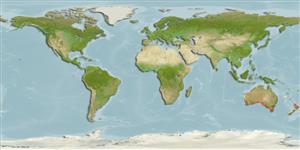>
Eupercaria/misc (Various families in series Eupercaria) >
Labridae (Wrasses)
Etymology: Pictilabrus: Latin, pictus = painted + Greek, labrax, -akos = a fish, Dicentrarchus labrax (Ref. 45335); laticlavius: Specific name alludes to the ornamental blue spots on the fins, similar to the clavi on the borders of the Roman patrician dress..
More on author: Richardson.
Environment: milieu / climate zone / depth range / distribution range
Écologie
marin récifal; profondeur ? - 40 m (Ref. 26203). Temperate
Eastern Indian Ocean: southern Australia, from southern Western Australia to New South Wales, including Tasmania.
Taille / Poids / Âge
Maturity: Lm ? range ? - ? cm
Max length : 23.0 cm SL mâle / non sexé; (Ref. 26203)
Inhabits rocky reef-algal habitats and occurs to as deep as 40 m (Ref. 26203).
Life cycle and mating behavior
Maturité | Reproduction | Frai | Œufs | Fécondité | Larves
Oviparous, distinct pairing during breeding (Ref. 205).
Russell, B.C., 1988. Revision of the labrid fish genus Pseudolabrus and allied genera. Rec. Aust. Mus. (Suppl. 9):1-72. (Ref. 26203)
Statut dans la liste rouge de l'IUCN (Ref. 130435)
Menace pour l'homme
Harmless
Utilisations par l'homme
Plus d'informations
Taille/ÂgeCroissanceLongueur-poidsLongueur-longueurFréquences de longueursMorphométrieMorphologieLarvesDynamique des populations larvairesRecrutementAbondanceBRUVS
RéférencesAquacultureProfil d'aquacultureSouchesGénétiqueElectrophoresesHéritabilitéPathologiesTraitementNutrientsMass conversion
CollaborateursImagesStamps, Coins Misc.SonsCiguateraVitesseType de nageSurface branchialeOtolithesCerveauxVision
Outils
Articles particuliers
Télécharger en XML
Sources Internet
Estimates based on models
Preferred temperature (Ref.
123201): 14.4 - 21.9, mean 17.2 °C (based on 116 cells).
Phylogenetic diversity index (Ref.
82804): PD
50 = 0.6250 [Uniqueness, from 0.5 = low to 2.0 = high].
Bayesian length-weight: a=0.00955 (0.00456 - 0.02002), b=3.06 (2.89 - 3.23), in cm total length, based on LWR estimates for this (Sub)family-body shape (Ref.
93245).
Niveau trophique (Ref.
69278): 3.6 ±0.4 se; based on size and trophs of closest relatives
Résilience (Ref.
120179): Milieu, temps minimum de doublement de population : 1,4 à 4,4 années (Preliminary K or Fecundity.).
Fishing Vulnerability (Ref.
59153): Low vulnerability (18 of 100).
Nutrients (Ref.
124155): Calcium = 21.3 [8.8, 38.9] mg/100g; Iron = 0.213 [0.114, 0.458] mg/100g; Protein = 18.8 [15.8, 21.0] %; Omega3 = 0.384 [0.206, 0.738] g/100g; Selenium = 5.77 [2.60, 12.91] μg/100g; VitaminA = 90.8 [22.5, 444.7] μg/100g; Zinc = 0.736 [0.475, 1.325] mg/100g (wet weight);
